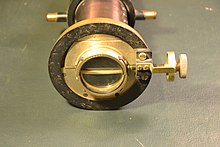Heliometer
A heliometer (from Greek ἥλιος hḗlios "sun" and measure) is an instrument originally designed for measuring the variation of the Sun's diameter at different seasons of the year, but applied now to the modern form of the instrument which is capable of much wider use.[1]
Description


The basic concept is to introduce a split element into a telescope's optical path so as to produce a double image. If one element is moved using a screw
History
The Syrian Arab astronomer Mu'ayyad al-Din al-Urdi, in his book, described a device called "the instrument with the two holes," which he used to measure and observe the apparent diameters of the Sun and the Moon.[2]
The first application of the divided object-glass and the employment of double images in astronomical measures is due to Servington Savery of Shilstone in 1743. Pierre Bouguer, in 1748, originated the true conception of measurement by double image without the auxiliary aid of a filar micrometer, that is by changing the distance between two object-glasses of equal focus.[1]

Notes
- ^ a b c One or more of the preceding sentences incorporates text from a publication now in the public domain: Gill, David (1911). "Heliometer". In Chisholm, Hugh (ed.). Encyclopædia Britannica. Vol. 13 (11th ed.). Cambridge University Press. pp. 224–230.
- ^ History Of Science And Technology In Islam Fuat Sezgin. 2011.
- ISBN 0-03-006228-4..
- ^ "Photos". klima-luft.de. Retrieved 16 August 2015.
- ^ ISBN 978-0-8050-7133-7.
Further reading
- Willach, Rolf. "The Heliometer: Instrument for Gauging Distances in Space." Journal of the Antique Telescope Society, number 26, pp. 5–16 (2004).
